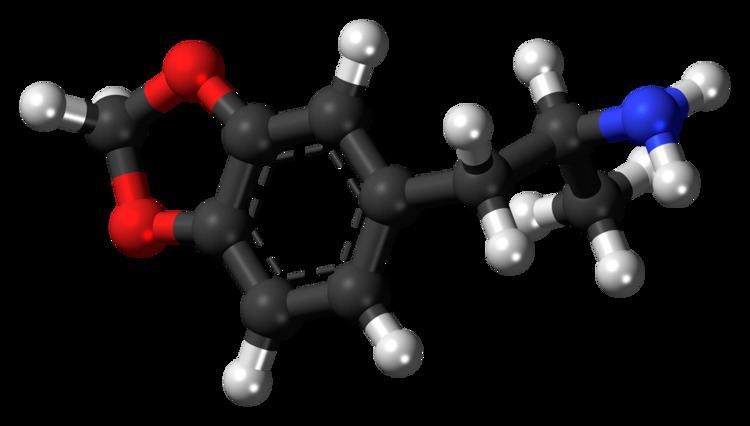ATC code None CAS Number 4764-17-4 Molar mass 179.22 g/mol | Excretion Renal Formula C10H13NO2 | |
 | ||
Routes ofadministration Oral, Sublingual, Insufflation, Intravenous Legal status AU: S9 (Prohibited)CA: Schedule IDE: Anlage I (Controlled)UK: Class AUS: Schedule IUN: Psychotropic Schedule I Metabolism | ||
3,4-Methylenedioxyamphetamine (MDA), also known as tenamfetamine (INN), is a psychoactive drug of the substituted methylenedioxyphenethylamine and substituted amphetamine classes of drugs that is consumed primarily for its entactogenic, psychedelic, and psychostimulant effects. Pharmacologically, MDA acts as a serotonin-norepinephrine-dopamine releasing agent and reuptake inhibitor. Possession of MDA is illegal in most countries. Some limited exceptions exist for scientific and medical research in few countries. The recreational use of MDA predates its more widely used analog MDMA (ecstasy).
Contents
Medical
MDA currently has no accepted medical use.
Recreational
Although illegal, MDA is bought, sold, and used as a recreational 'love drug', due to its enhancement of empathy. A recreational dose of MDA is commonly between 100 and 160 mg.
Overdose
Symptoms of acute toxicity may include agitation, sweating, increased blood pressure and heart rate, dramatic increase in body temperature, convulsions, and death. Death is usually caused by cardiac effects and subsequent hemorrhaging in the brain (stroke).
Pharmacodynamics
MDA is a substrate of the serotonin, norepinephrine, and dopamine transporters, as well as a TAAR1 agonist, and for that reason, acts as a reuptake inhibitor and releasing agent of serotonin, norepinephrine, and dopamine (or as an SNDRA). It is also an agonist of the 5-HT2A, 5-HT2B, and 5-HT2C receptors, and shows affinity for the α2A-, α2B-, α2C-adrenergic receptors and 5-HT1A and 5-HT7 receptors.
The effect on serotonin may explain the similar entactogenic effects of MDMA and MDA. However, (S)-MDA has a higher efficacy in agonizing the 5-HT2A receptor than (R)-MDMA; thus MDA tends to cause more psychedelic-like effects, such as visual hallucinations. MDMA can also produce psychedelic-like visual effects, though these are generally less pronounced than those of MDA or require higher doses to become apparent. Relative to MDMA, MDA is also a more potent releasing agent of norepinephrine and dopamine and hence is more stimulating in comparison, and is also notably several-fold more neurotoxic to serotonergic neurons.
Pharmacokinetics
The (S)-optical isomer of MDA is more potent than the (R)-optical isomer as a psychostimulant, possessing greater affinity for the three monoamine transporter proteins (SERT, NET and DAT). The duration of the drug has been reported as about 6 to 8 hours.
Synthesis
MDA is typically synthesized from essential oils such as safrole or piperonal. Common approaches from these precursors include:
Detection in body fluids
MDA may be quantitated in blood, plasma or urine to monitor for use, confirm a diagnosis of poisoning or assist in the forensic investigation of a traffic or other criminal violation or a sudden death. Some drug abuse screening programs rely on hair, saliva, or sweat as specimens. Most commercial amphetamine immunoassay screening tests cross-react significantly with MDA and major metabolites of MDMA, but chromatographic techniques can easily distinguish and separately measure each of these substances. The concentrations of MDA in the blood or urine of a person who has taken only MDMA are, in general, less than 10% those of the parent drug.
History
MDA was first synthesized by C. Mannich and W. Jacobsohn in 1910. It was first ingested in July 1930 by Gordon Alles who later licensed the drug to Smith, Kline & French. MDA was first used in animal tests in 1939, and human trials began in 1941 in the exploration of possible therapies for Parkinson's disease. From 1949 to 1957, more than 500 human subjects were given MDA in an investigation of its potential use as an antidepressant and/or anorectic by Smith, Kline & French. The United States Army also experimented with the drug, code named EA-1298, while working to develop a truth drug or incapacitating agent. Harold Blauer died in January 1953 after being intravenously injected, without his knowledge nor consent, with 450 mg of the drug as part of Project MKUltra. MDA was patented as a cough suppressant by H. D. Brown in 1958, as an ataractic by Smith, Kline & French in 1960, and as an anorectic under the trade name "Amphedoxamine" in 1961. MDA began to appear on the recreational drug scene around 1963 to 1964. It was then inexpensive and readily available as a research chemical from several scientific supply houses. Several researchers, including Claudio Naranjo and Richard Yensen, have explored MDA in the field of psychotherapy.
Australia
MDA is schedule 9 prohibited substance under the Poisons Standards. A schedule 9 substance is listed as a "Substances which may be abused or misused, the manufacture, possession, sale or use of which should be prohibited by law except when required for medical or scientific research, or for analytical, teaching or training purposes with approval of Commonwealth and/or State or Territory Health Authorities."
United States
MDA is a schedule 1 controlled substance in the US.
Research
In 2010, Matthew Baggott and colleagues studied the ability of MDA to invoke mystical experiences and alter vision in healthy volunteers.
Derivatives
Tenamfetamine also constitutes part of the core structure of the LABA Protokylol.
